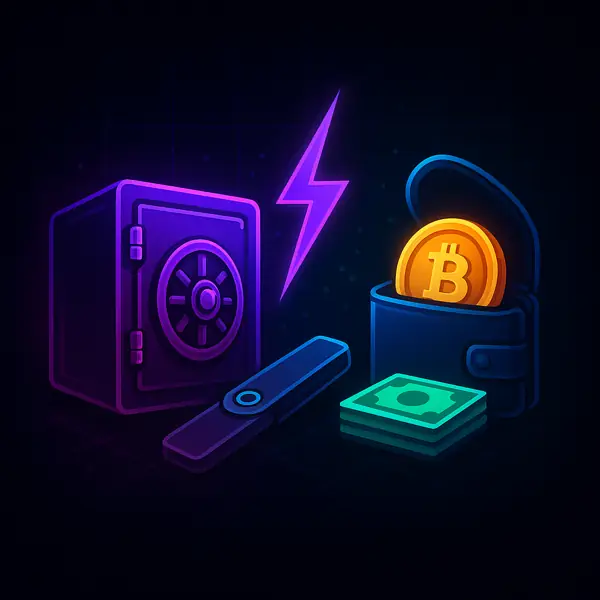One of the first choices every crypto user faces is: should you trust an exchange to hold your crypto, or should you take control yourself?
That’s the debate between custodial and non-custodial wallets. If you’ve seen the phrase “not your keys, not your coins”floating around crypto Twitter, this is exactly what it’s about.
Let’s break it down in simple terms so you know which wallet is safer for you — and when each option makes sense.
What Is a Custodial Wallet?
A custodial wallet is when a third party holds your private keys. In plain English, you don’t fully own the crypto — you have an account that says you own it, but the company is in charge of custody.
Examples:
- Binance Exchange Wallet
- Coinbase Exchange
- Kraken Exchange Wallet
- Bitfinex, OKX, Bybit
When you log in with a username and password, and you can reset that password with email or SMS, you’re using a custodial wallet.
Pros of Custodial Wallets:
- Easy to set up — no seed phrase to manage.
- Password recovery if you forget access.
- Integrated with trading, staking, or fiat deposits.
- Customer support if something goes wrong.
Cons of Custodial Wallets:
- You don’t own the keys → if the exchange freezes or gets hacked, you lose access.
- Subject to KYC/AML checks and withdrawal limits.
- History of collapses — FTX, Mt. Gox, Quadriga.
Custodial wallets are like keeping money in a bank. Convenient, but not 100% in your control.
What Is a Non-Custodial Wallet?
A non-custodial wallet is when you hold the private keys yourself. Nobody else can touch your funds unless they get your keys.
Examples:
- MetaMask (Ethereum, Layer 2s, DeFi, gambling dApps)
- Trust Wallet (multi-chain, very beginner-friendly)
- Phantom (Solana)
- Ledger & Trezor (hardware wallets)
Pros of Non-Custodial Wallets:
- Full control over your crypto.
- Access to Web3: DeFi, NFTs, casinos, DEXes.
- No withdrawal limits or middlemen.
- Resistant to exchange shutdowns.
Cons of Non-Custodial Wallets:
- Lose your seed phrase = lose your funds.
- If hacked or phished, there’s no customer support to recover.
- Can be confusing for beginners.
- Gas fees and network management required.
Non-custodial wallets are like keeping cash in your own safe. Ultimate control, ultimate responsibility.
Real-World Lessons
- FTX (2022 collapse) → Millions of users lost access to funds overnight because they trusted a custodial wallet. Lesson: not your keys, not your coins.
- Ledger (hardware wallets) → Sold over 6 million devices. Many pros store millions safely this way. Lesson: serious investors go non-custodial.
- Coinbase → One of the most regulated exchanges. Safer than sketchy platforms, but still custodial. Lesson: reputation matters if you stay custodial.
When to Use Custodial vs Non-Custodial
Custodial wallets are good for:
- Beginners who don’t want to deal with seed phrases yet.
- People trading often on exchanges.
- Users buying crypto with fiat cards.
- Those who want easy access and customer support.
Non-custodial wallets are good for:
- Anyone serious about security and self-sovereignty.
- Players who want to gamble or use DeFi protocols.
- Long-term holders (HODLers).
- Whales and investors with large bags.
The smart move is often to use both:
- Keep trading funds on a custodial exchange wallet.
- Move real holdings into a non-custodial wallet.
Custodial vs Non-Custodial: A Quick Comparison
| Feature | Custodial Wallet | Non-Custodial Wallet |
|---|---|---|
| Who holds keys | Exchange/platform | You |
| Ease of use | Very easy | Steeper learning curve |
| Recovery | Password/email reset | Seed phrase only |
| Access to Web3 | Limited | Full |
| Security | Trust the company | Trust yourself |
| Risk | Exchange collapse, freezes | Hacks, lost keys |
Stats That Matter
- Around 60% of crypto users still hold funds in custodial wallets (Binance, Coinbase).
- Over 30 million people use MetaMask monthly — non-custodial adoption is rising fast.
- FTX collapse wiped out $8B+ in customer deposits in 2022. A brutal reminder of custodial risk.
Final Word
So, custodial vs non-custodial — which should you choose?
If you want convenience, trading, and fiat access, custodial wallets are fine. Just stick to reputable exchanges and don’t keep your life savings there.
If you want true ownership, security, and access to Web3 gambling, DeFi, and NFTs, you need a non-custodial wallet. It comes with more responsibility, but also more freedom.
The best move? Use both strategically. Custodial for easy trades and fiat ramps, non-custodial for long-term storage and on-chain adventures.
Remember: exchanges can go bankrupt. Smart contracts can’t. That’s why in Web3, the real power is always with the wallet you control.
Wagmi 🚀


